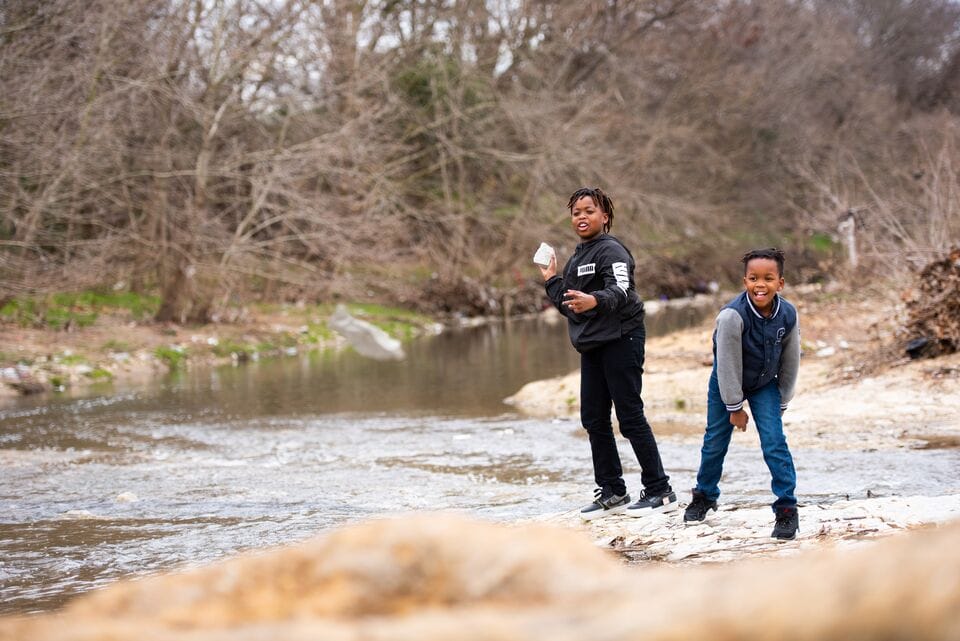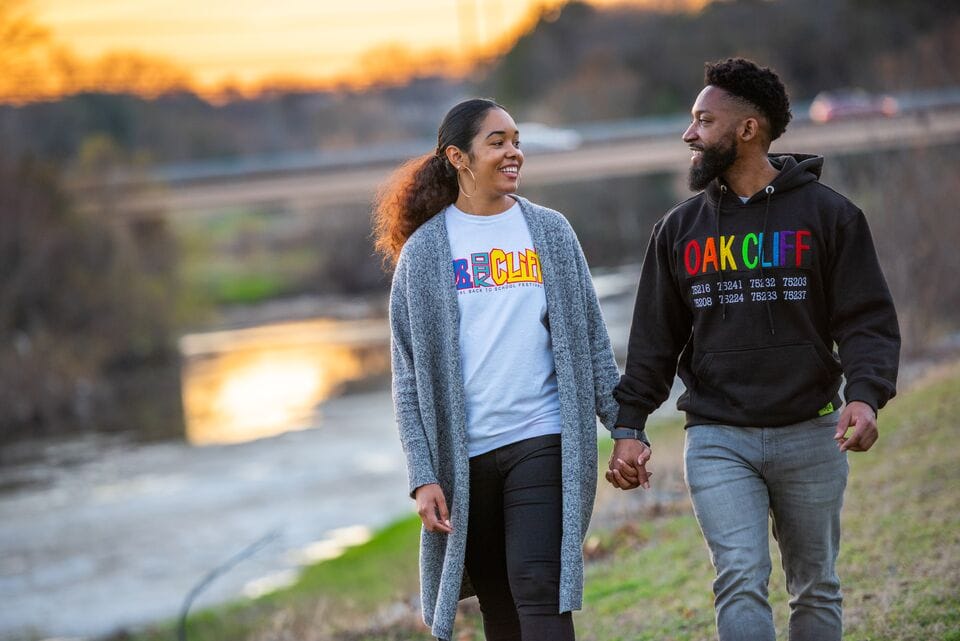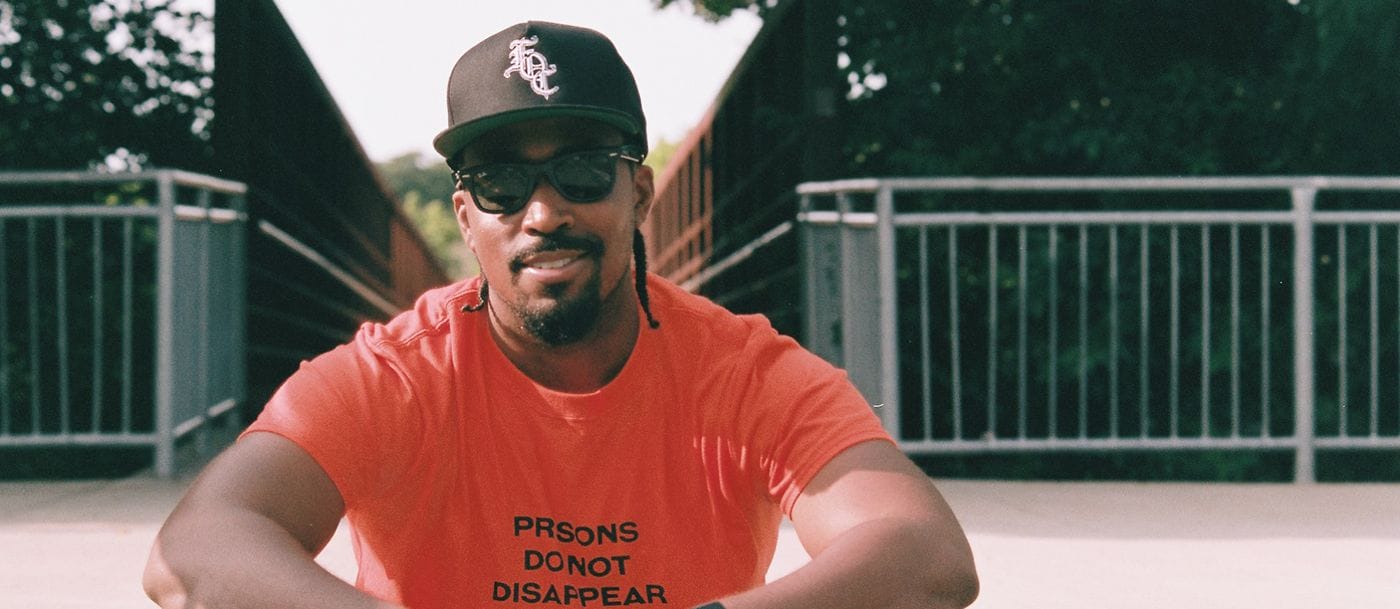As a kid growing up in the South Oak Cliff section of Dallas, Taylor Toynes remembers long afternoons spent exploring the creek that cuts through the neighborhood. Sunk below street level, undeveloped, and overgrown, Alice Branch Creek was a “hidden jewel…it could actually be beautiful down in there,” Toynes says. But without any trails or maintenance, the creek became a place most folks avoided, more of an eyesore than a place to connect with the outdoors—something Toynes says is needed in a neighborhood with too few parks and high rates of chronic illness.
When Toynes came back to Oak Cliff after college to teach elementary school, he started to see how this pattern of unrealized potential played out in so many aspects of his students’ lives. They were bright, kind, and hardworking kids, but their families too often struggled to afford their basic needs.

Alice Branch Creek is a source of potential for residents of Dallas’s Oak Cliff neighborhood. Photo: Jason Flowers
So in 2014 Toynes started For Oak Cliff, a community organization with a mission to liberate Oak Cliff from systemic oppression through a culture of education, social mobility, and social capital.
Today, we’re working alongside For Oak Cliff and other community organizations to build new parks throughout the neighborhood—including South Oak Cliff Renaissance Park along Alice Branch Creek, which is part of our Five Mile Creek Greenbelt project. We sat down with Toynes [who joined TPL’s National Board of Directors in 2021] to learn more about his leadership and how parks are key to what he calls “the upcoming Oak Cliff Renaissance.”
Donate today to support our working creating more equitable green spaces in Texas.
What’s your vision for Oak Cliff?
When you look at a thriving neighborhood, there are a few things that have to be in place for everything to play out well. One, you need a space for economic development: a hub where dollars can be spent and circulated, and where business owners can work within the community. Two, you need great educational opportunities, with resources and facilities to help students achieve their best. And three, you need parks—a place for people to recreate and play.
How does For Oak Cliff approach these goals?
All these issues we face—from lack of park space, lack of educational investment, poverty, crime—they have a root cause in racism. It’s a long history of policies that were specifically designed to oppress African American communities. Don’t forget it wasn’t too long ago that the mayor of Dallas was a member of the Ku Klux Klan.
My dad used to say, “A drowning person will reach for a rope full of razor blades to pull himself to safety.” For Oak Cliff is trying to remove some of those razor blades so people don’t get so cut up by the struggle to get free.
How do you get rid of those razor blades?
We emphasize building capacity within the community and involving the community intentionally. This neighborhood is a resilient place and our people have been fighting for equality for a long time. Our high school was so rundown that our students actually staged a walkout in protest. That’s what it took to get money for a renovation, so finally our kids can go to school in a building they deserve. We’ve also been a food desert, but we’re making progress on a plan to rebuild a shopping center and open a nonprofit grocery store. All this change is coming from within the community.

“The community has been involved every step of the way,” says Toynes about the plans for new parks in Oak Cliff. Photo: Mark Graham/The Nature Conservancy
Given all the serious issues you’re taking on, why are parks a priority?
It’s all part of this broader renaissance that’s going on in the neighborhood right now. Having those play spaces is really important for our environmental health, which affects our physical health, and our mental health too: say you’re a kid in a tense situation, and you don’t have anywhere to go to exert that energy in a positive way. Mentally, that could really faze you! That can harm you. You can go out and explode. We have youth that are doing that, because they don’t have a space they can go to express themselves in any other way.
What’s the current situation with parks in Oak Cliff?
I’ve served on the Dallas Parks Board, so I’ve been all over the city to see parks in different neighborhoods. In the history of park investments across Dallas, there’s never been a fair process for deciding how dollars are spent. The same creek that’s a dilapidated area in Oak Cliff, in other neighborhoods there’s a beautiful trail along it.
The issue in our neighborhood isn’t a lack of open space. We’re in Texas—we have plenty of that. But we need more than space. We need intention, investment, and amenities that make these spaces really work. How can we create a park that could hold our kids’ attention spans, help teach them about engineering or ecosystems? How can we design these spaces to bring energy that everyone can enjoy? That’s what we want to bring to our neighborhood. I’m really looking forward to what’s going to come out of it.

Trust for Public Land is helping Oak Cliff residents plan major improvements to green space throughout the neighborhood, including a new park and trail along Alice Branch Creek. Photo: Jason Flowers
How can other organizations support you?
Anyone who wants to be involved in our neighborhood needs to wholeheartedly embrace the knowledge that our community members are the experts. I don’t care who you are, what your background is. You could have ten advanced degrees, it doesn’t matter. These issues you want to help address, from education to incarceration rates to the environment? They’re our reality and our upbringing. It’s been generations of people that have been able to live, breathe, and raise families here. We have a wealth of knowledge, and it needs to be honored more.
Sometimes when an outside group comes in, it’s like: you could be having a holiday meal and a guest comes into your house and says, “This looks good, but we brought something else and you should eat that instead.” It’s been generations that we’ve been pushed aside like that. Maybe you even could have brought in a much better meal, but you didn’t acknowledge or receive what we already have on the table.
What are some ways to honor that knowledge?
The process of creating this greenway with Trust for Public Land been a success because the community has been involved every step of the way, and we’ve been making decisions about what this place can be. So it will be a place that’s representative of our community.
What does solidarity look like to you?
If you have some power in society, use it to advocate for the issues that we advocate for. There’s a laundry list of things you can put your power behind: defunding the criminal justice system, abolishing prisons, abolishing the police.
I’ve been in South Oak Cliff almost all of my life, and I can tell you that nothing has really changed since I was a kid. Some of the changes I just listed might sound radical to you, but the system we live in now has always been radical in the way it has oppressed marginalized communities like ours. So if you really want to see a change, be as radical as you possibly can.
A version of this interview appeared in the Fall/Winter 2020 issue of Land&People magazine, a benefit to members of Trust for Public Land.
One-third of Americans, including 28 million children, lack safe, easy access to a park within a 10-minute walk of home. Urge your senators to allocate funding to create parks and enhance outdoor recreational opportunities by championing the Outdoors for All Act today!

Donate to become a member, and you’ll receive a subscription to Land&People magazine, our biannual publication featuring exclusive, inspiring stories about our work connecting everyone to the outdoors.

